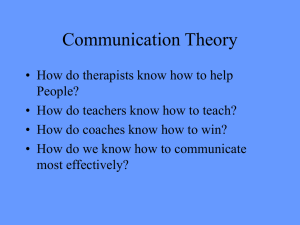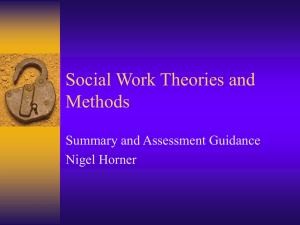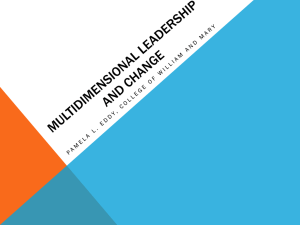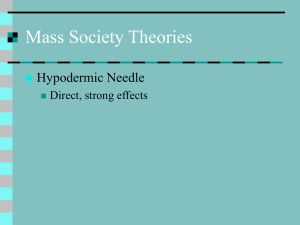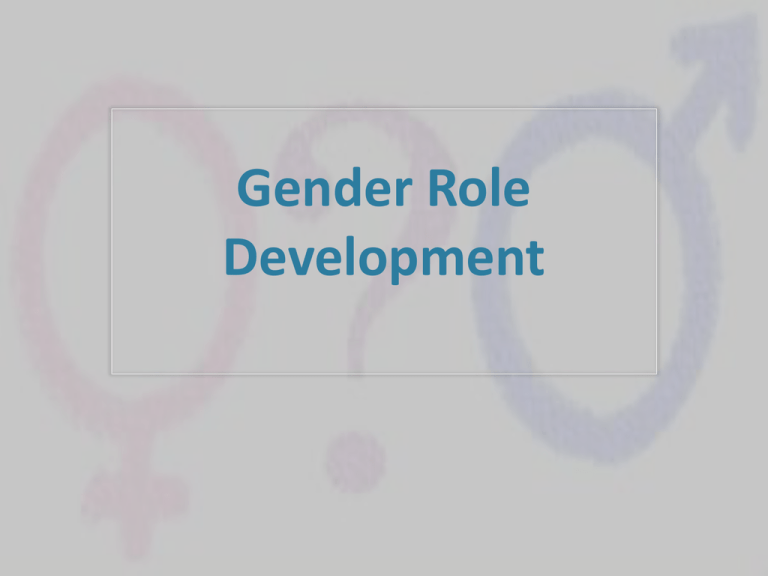
Gender Role
Development
What are little
boys made of?
Frogs and snails,
And puppy-dogs'
tails;
That's what little
boys are made of.
What are little
girls made of?
Sugar and spice,
and all that's nice;
That's what little
girls are made of.
What is Gender?
Gender refers to the identity a person adopts as a result of
developmental processes. Gender identity is usually linked to
biological sex organs but this is not always the case. Some women
adopt a masculine identity, some men adopt a feminine identity.
Identity formation is an active cognitive process and is therefore
open to influence from innate physiological processes as well as
from social forces (such as media, cultures, parenting and so on).
Gender role refers to the sets of behaviours, rights, duties and
obligations of being male or female (Bee, 1995).
It is therefore a schema, a mental guide for action, steering an
individual towards a socially agreed construction of gender
expression.
What is Gender?
Some Native American and Canadian First Nation indigenous
groups allow for multiple genders to exist at the same time in a
person via the two-spirit concept. This concept recognises that an
individual may possess both male and female identities.
In Oman, the Xanith form an accepted third gender in a strictly
gender-segregated society. They are usually male homosexual
prostitutes who dress as males but have female mannerisms.
Xanith mingle with women but they also run their own
households, performing all tasks of both male and female gender
roles (Lorber, 1994).
Western cultures have a notion known as androgyny (Bem, 1974).
So if you wanted to, could you
raise your child to be
gender neutral?
The vocabulary of sex & gender
A. Biological Gender – anatomical and
physiological attributes
Difference are universal, biological determined,
and unchanged by social influence. Some would
say this leads to:
the development of social roles? (Ev. Psy. – be
careful)
Breast feeding = care for infants
Stay close to home while men hunt and gather =
physical strength difference (Rossi, 1984)
The vocabulary of sex & gender
B. Gender identity – one’s sense of maleness or
femaleness – an awareness & acceptance of one’s
and others maleness or femaleness – age 2
• Gender consistency: no mater what you do/look etc. your
gender remains the same – around age 7
C. Gender roles (typing) – What society says each
gender should do (The IB focus!)
what society/culture teaches children about what
behavior is appropriate for each sex – a process
D.What to attribute to nature/nurture is up for
debate!
Gender Behaviour
High degree of agreement across 30 cultures
of gender behavior/roles (Williams & Best,
1994)
Male:
Aggressive, better a spatial abilities, assertive
Females:
verbal, nurturing, emotionally more sensitive,
gentle
Is this due to socialization (societies
influence) or some other reason?
Biological Theories of Gender Development
1. Biology (hormones) & Gender roles
A. Evolutionary Psychology
Natural selection based on division of labor has
created different gender roles
Know the mechanisms of evolutionary theory
E.O. Wilson – different gender roles equal to division
of reproduction & labor
Males hunt & females tend babies because of physical
features
Mating strategies = roles/behavior
Parental investment theory (Kenrick, 1994)
Society organized by gender to exclusive meet female needs
Biological Theories of Gender Development
1. Biology (hormones) & Gender roles
A. Evolutionary Psychology
Critics: gender roles not the result of
evolution, but a consequence of culture
assigning roles
There are cross-cultural differences as
well as similarities in gender roles
Development of gender roles should be
seen as an interaction of biological &
social-cultural factors
Biological Theories of Gender Development
1. Biology (hormones) & sexual Identity
B. Hormones influence on gender
(Testosterone/androgens) – “Theory of
psychosexual differentiation”
In prenatal development testosterone is
released
This influences brain development
Male ‘brain circuitry’ – spatial abilities,
aggression
How do we know?
Use of case studies – naturally occurring events
(next slide)
Biological Theories of Gender Development
2) Hormone influence on gender roles
Bailey, 2003: 200 healthy children
Found positive correlation between
levels of testosterone in amniotic fluid
and later measure of male-type play
CAH disorder: XX exposed to high levels
of testosterone in uterus
Girls have more male type behavior
Biological Theories of Gender Development
B. Hormones (cont.)
Chromosome (XX & XY) influence: case studies
1) Chromosome influence on gender roles & how society ‘labels’
them & subsequent behavior
Reiner & Gearheart, 2004: longitudinal study of 16 genetic
males - rare disorder of being born without a penis –
otherwise everything else is normal (had testicles)
2 raised as male & developed male gender identity
14 surgically altered and assigned female role
8 have since declared themselves male
5 living as females
1 is unclear in gender identity
Money (1974): Accidental penectomy –– David Reimmer
born male, raised female, unhappy, became male
Theories of Gender Development
Zucker, 1999: “A persons gender identity
depends on the interaction of genes,
prenatal hormones, anatomical structures,
and experiences.”
Theories of Gender Development
Children not passive, but select whom
they copy (same sex) (Bandura & SLT)
Children are gender police
Fagot, 1985 – observations study of
children between 21 – 28 months
Those children who did not behave in
gender appropriate ways were made fun of
by other children
Cognitive Theories of Gender Development
Cognitive Development Theory
Kohlberg (1966) argued children acquire greater
understanding of gender as cognition matures – this means
children can only acquire gender identity and enact
appropriate role behaviours when they are mentally ready.
Initially, children acquire a gender concept and then actively
seek information from members of the same gender for
clues on how to behave. Once they understand gender is
fixed and they are to be a boy or a girl forever, they become
increasingly motivated to find information on appropriate
behaviours.
Cognitive Theories of Gender Development
Cognitive Development Theory
Kohlberg thought gender identity was acquired
between the ages of 2 and 3. Between the ages of 3
and 7, the child understands gender is largely fixed but
can still change if there is a change in appearance such
as hair or clothing. Gender constancy occurs between 4
and a half and 7 years old. This represents a form of the
Piagetian notion of conservation as the child
understands gender as immovable regardless of
superficial changes.
Cognitive Development Theory
Marcus and Overton (1978) report gender conservation
occurs at the same time as other forms of conservation
suggesting the process has clear cognitive developmental
origins.
Slaby and Frey (1975) divided 2–5-year-olds into two
groups: one group they considered to have high gender
constancy, and the other group they considered to have low
gender constancy. They showed a film with a split screen;
one side had male models performing a task, the other side
had female models performing a task. Children with high
gender constancy had more same-sex bias in their
attention. This shows children actively seek and then
respond to appropriate gender models.
Cognitive Theories of Gender Development
3. Gender Schemas (Cognitive Perspective)
A mental network of attitudes, ideas, etc of
what it means to be male/female, Bem, 1993
By age 9 months schemas start developing –
differentiate between male and female faces (Fagot,
1993)
Actively constructed gender schemas
develops fully by age 4
Martin & Halverson, 1983: Experiment – 5-6 year
olds showed gender congruent & incongruent
pictures
Week later – remembered boy, not girl, playing
with gun
Gender Schema Theory
Liben and Signorella (1993) found that children
who were shown pictures of adults engaged in
perceived gender inversion behaviour (e.g. a
male nurse) disregarded the information and
forgot it – suggesting children are actively
engaged in constructing their world view and
only select information that supports their vision
of gender-appropriate behaviour.
Socio-Cultural Theories of Gender Identity
Hidden Reinforcers
Adults respond/reinforce aggressive boys,
talkative girls (Fagot et al, 1985)
“Boys will be boys”
(Jacobs & Eccles, 1985) Math – boys – you’re
a natural whiz, Girls – you must have worked
hard
How do you respond to young children of
different gender?
Socio-Cultural Theories of Gender Identity
3.Gender is expressed in a Social Context
We behave in both male & female ways
depending on the social context
Strong gender producing situations produce
strong gender roles: Geis, 1991
Dating
Makeup of group
4.Social Role Theory, Eagly, 1987: Gender roles
come from different work role
Socio-Cultural Theories of Gender Identity
Social learning theory
Social learning theory assumes children learn genderappropriate and gender-inappropriate behaviour via processes
present in the environment/culture such as modelling and
conditioning through reward and punishment.
Reinforcement can be direct and explicit:
‘You look like a girl in that hat’ (said to a boy)
‘Girls don’t wear jeans’ (said to a girl).
Or it can be more subtle in the form of media images and
expectations in peer groups.
Learning the Rules of Gender Identity
Lamb and Roopnarine (1979) observed nursery-age children at play and
found they reinforced each other for gender-appropriate play. They also
noted reinforcement was more potent if it came from the same gender as
the child being reinforced.
Leary et al. (1982) found children who were frequent television watchers
are more likely to hold stereotyped ideas about gender and conform more
to gender role preferences – suggesting the potency of modelling
behaviour from media.
Lewis (1972) observed parent–child interaction and found boys were
encouraged to be active and independent and girls were encouraged to be
passive and dependent.
It should be noted, these Western-centric studies have a degree of
ecological validity as they were conducted as observations but they were
also in a time when gender roles were more clearly defined and caution
must be used when contemporizing the results either to current Western
society or to other cultures.
Theories of Gender Development
Social Construction
A. Any differences in gender roles between cultures
supports the idea of learned roles
B. Margaret Mead (1935) – claimed that gender is
cultural – Cultural determinist – 3 New Guinea
tribes – all had different concepts of gender
1) Changed her mind after birth of own child &
study of more cultures
• Motherhood = biological inclination, Fatherhood =
social invention
2) Biological determinist! (1949)
Socio-Cultural Theories of Gender Identity
Shift to modern world
Goffman, 1977: predicts that gender roles will switch
from a belief that gender roles are due to biological
differences to a belief in general social equity
Support for this in new role of males & females in
Western culture
Reinicke, 2006 – young fathers in Denmark find
childcare an important part of their identity
Engle, 1994 – found that if fathers participated in
parenting classes, they took on more of a caregiver role

